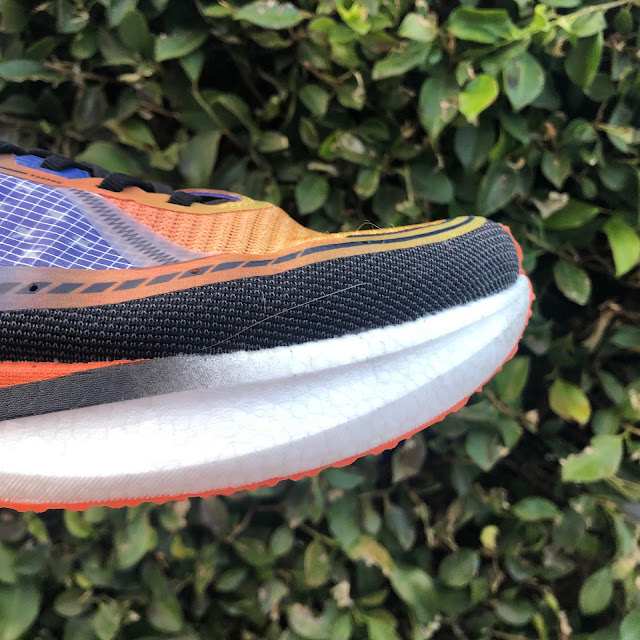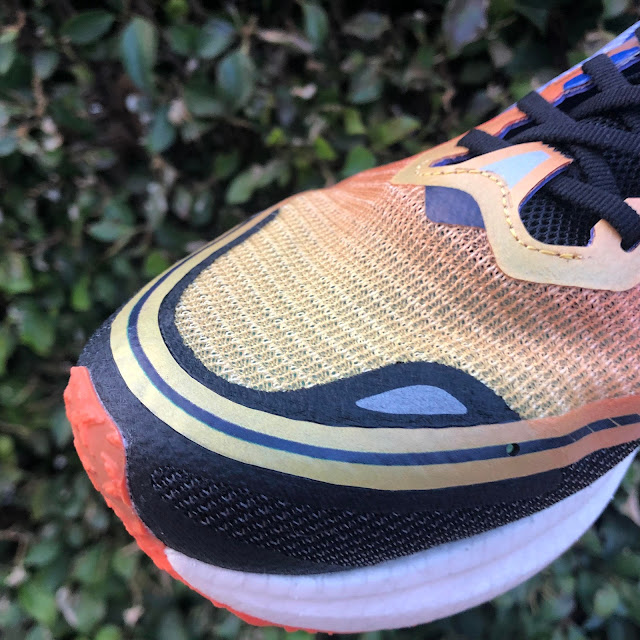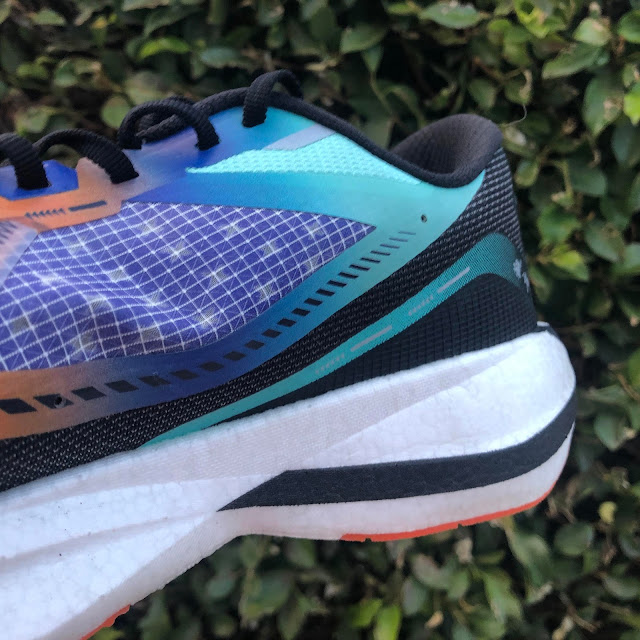Xtep RC260 Review: A Unique Plated Trainer
By Chief Editor Matthew Klein
As a true shoe geek, I keep tabs on what shoes are coming out around the world. Sometimes I just get to look at them and other times I am actually able to get my feet in them. I previously reviewed the Xtep 160X 1 and 2 (REVIEW), but saw the Xtep RC 260 released. While the Xtep 160X series are definitely racing shoes, the RC 260 appeared to be more along the lines of a lightweight trainer featuring a similar Peba foam. Several weeks later these came in and my first thought was that they would be similar to the Saucony Endorphin Speed 2 (REVIEW), particularly with the Peba foam and nylon plate. That's where most of the similarities end as these are two different shoes.
Xtep RC260Price: $135 at Global Xtep
Weight: 8.7 oz, 247 g (men's size 8), women's specs not provided
Stack Height: 28 mm / 20 mm
Drop: 8 mm
Classification: Lightweight Trainer
RUNNING SHOE SUMMARY
The Xtep RC 260 is a nylon-plated, PEBA soled lightweight trainer for those with narrow and stable feet. An extremely soft midsole is paired with a narrow last and a moderately stiff nylon plate. The upper is stiff and narrow, providing a tapered fit that will work for those with narrow foot shapes, especially in the forefoot. The Xtep RC 260 is best for uptempo efforts, tempo workouts, and potentially daily training if your mechanics are stable enough to tolerate it.
FIT
The Xtep RC 260 fits me true to size in my normal US men's size 10. It is narrow, particularly in the forefoot. There are thick overlays on the upper of this shoe that are especially prevalent upfront, which contribute to a narrow and tapered toebox. The inner aspect of the upper keeps the toe guard against the foot, which combined with this taper caused me to blister on anything longer than shorter efforts. For that reason, I would suggest using socks if running in this shoe. There is mild cushioning around the heel collar that covers a prominent and stiff heel counter. It was noticeable and caused me some irritation at my Achilles insertion. For those with heel sensitivities, this is not an optimal shoe. The fit in midfoot is more normal width and I had to tighten the laces to get a solid lockdown. There is no last eyelet to lace lock the shoe. I had to tighten down the midfoot even more to get a secure fit as my foot was hanging off the medial aspect of the midfoot. The tongue is thin and free-floating. I had to spend extra time making sure it laid down flat, as I experienced some bunching. Overall the Xtep RC 260 is best for those with narrow feet wanting a stiff heel counter and an upper with a high number of overlays.
PERFORMANCE
The Xtep RC 260 features a full-length PEBA sole providing a soft and bouncy ride. There is a nylon plate that provides mild to moderate stiffness, but the amount of give from the midsole dampens this. The ride reminded me of a softer Saucony Endorphin Speed but with a far narrower and less stable sole. The ride is soft no matter what the speed and feels best running at uptempo/tempo paces. The sole is too soft for extremely fast paces as it does not respond quickly enough. However, for tempo efforts, the bounce is enough to provide protection and some turnover. The weight of this shoe puts it more as a lightweight trainer, with enough underfoot protection for mileage but being bouncy enough for some workouts mentioned above. The heel has a large bevel that is centered. The lateral flare causes my foot to pitch in during initial contact, so those that land extremely lateral at the heel should be cautious at first. As the sole breaks in this is no longer an issue. The heel transition is soft and rolls forward to an odd midfoot. The narrowness of the sole at the midfoot and flexibility of the plate at this point causes the midfoot to give a bit during the midfoot transition. This is especially noticeable during slower paces and recovery efforts. Once you get over this, the forefoot transitions decently with the nylon plate. It is not stiff and feels mildly flexible. There is toe spring, but the nylon plate does flex especially the harder you push off. The durability of the RC 260 is excellent. I have over 30 miles on my pair and there is really no wear on the outsole (minus some dirt). Thus, this shoe wears more like a lightweight trainer, and those who can tolerate the design will get a solid amount of miles out of these at a decent price ($135).
STABILITY
The Xtep RC 260 is a neutral shoe and there are no major methods of stability outside of a heel counter. The R 260 is actually extremely unstable for several reasons. While there is some mild sole flare at the heel, the overall last is extremely narrow. My feet were almost hanging off the side of the shoe. The midfoot is not only incredibly narrow, it is narrower than the rest of the shoe. Despite the nylon plate, this gives the shoe a high amount of torsional flexibility. Combined with the extremely soft PEBA sole, moderate to high stack height, this is one of the least stable shoes I have ever tried. For anyone that needs even mild stability, avoid this shoe. However, if you are sensitive to any form of stability, then this may be a shoe for you.
THOUGHTS AS A DPT / FOOTWEAR SCIENCE
Unless you have extremely narrow and rigid feet and want a soft and flexible ride, this shoe is probably not going to work for you. Basic concepts in physics dictate that softer surfaces and structures with narrow bases are inherently less stable. The Xtep RC 260 has one of the most narrow shapes I have seen recently in a shoe. Even worse, the midfoot is narrower than any normal human foot. With so little material there compared to the rest of the sole and a more flexible plate, the shoe ends up flexing easily at the midfoot. This is an issue I discussed that occurred to a mild to a moderate degree in the Xtep 160X series. However, with the combination of a super soft sole, a plate that creates more stiffness at the heel and forefoot, and the narrowness of the sole, this shoe creates a high level of instability and with so little comparative resistance, a strong flex point in the midfoot.
To be able to run in this shoe, there are several requirements. The runner must have extremely stiff feet, as the softer sole and instability will force them to shock absorb. There is a risk of ankle sprain, which may be more severe in those with stiffer ankles due to a lack of compensatory mobility, due to the higher stack and narrower sole. Thus, the runner must also have extremely strong ankles/feet, particularly in the frontal plane (side to side). The runner must have extremely narrow feet as that is the only match for a sole this narrow. Having one's feet hanging over the edge of the shoe is not good and increases the instability and risk of rolling one's ankle. Finally, the runner must have an extremely fast transition when their foot is on the ground. This may reduce the amount of flex at the midfoot. Shoes are tools and the job of each runner is to find out which tools work for them. Unfortunately, this is a tool that will not work for most of the population.
RECOMMENDATIONS
The design of the Xtep RC 260 needs to be completely overhauled. This is one of the most unstable shoes I have tested, the fit is poor in the forefoot and the shoe is flexing in the wrong places. It is not advisable to make a higher stack shoe with a narrow last. It is inherently unstable and the RC 260 does nothing to compensate for it. If this is really to be a lightweight training option, then the sole needs to be widened. The fit is narrow and tapers extremely quick in the forefoot. This compresses the toes and as mentioned caused me some blisters. I would suggest widening this out and using some alternative materials that fit better around particularly the front of the foot. The plate and flexibility are things I have mentioned with some other Xtep shoes, however, this is much worse. The flexible nylon plate allows for a high level of flexibility at the midfoot in the sagittal plane, which I have discussed extensively does not have a joint that moves in the sagittal plane like that. The flexibility needs to be tuned to provide rigidity from the heel to midfoot and flexibility at the toes for an appropriate transition through toe-off. At this time, there is a great deal of work that needs to be done on this design.
WHO THIS SHOE IS FOR
The Xtep RC 260 is an extremely soft lightweight trainer for those with narrow feet, who transition quickly and do not need any stability. The full-length PEBA foam is soft and bouncy, providing a solid ride for uptempo and tempo efforts. The nylon plate provides some rigidity to the sole without being stiff, but the design tends to flex a great deal in the midfoot. The upper is narrow with a stiffer toe guard, so those looking for a tapered toe box and narrow shape will do well here. The last is incredibly narrow, so those with narrow feet or anyone who enjoys their foot hanging off the side of the shoe will do well in the Xtep RC 260 for use as a moderate pace workout shoe or lightweight trainer.
Overall I am quite disappointed with the design of this shoe. There are several things done that may increase the risk of strain on different tissues in this shoe. This is especially sad as the midsole actually feels great. The softness and bounciness is great, but Xtep really needs to change the width and midfoot design if this is to be a successful shoe. I have high expectations, so hopefully, version 2 can fix this.
GRADING
Matt
Fit: B- (Narrow fit with tapered toebox, strong overlays that contributed to blisters if you have normal to wider feet. Upper security is decent, but is missing the last lace hole for an optimal lockdown.)
Performance: B+ (The midsole is actually good. Soft, bouncy and great for uptempo/tempo efforts. However, the design creates a flex point in the midfoot, which combined with the instability can be uncomfortable unless you have narrow rigid feet)
Stability: D (Extremely narrow last combined with excessive midfoot flexibility and an even narrower midfoot make this one of the most unstable shoes I have tried. I'm not giving this an F because of some mild rigidity from the nylon plate and very mild medial/lateral heel flare)
DPT/Footwear Science: D+/C- (Extremely flexible in midfoot with last narrower than a majority of the feet out there. Combining a higher stack height with a soft sole, high flexibility in the wrong places and a last this narrow with a high stack shoe is not good)
Personal: D (The ride is far too unstable for me, the fit is off, I have gotten blisters. I won't be running another step in these. These may work for someone, but not for me)
Overall: C- (Best for those with narrow feet who want a more affordable plated PEBA who do not need any form of stability)
SHOP | SUPPORT DOR
Price: $135 at Global Xtep
The link used for the RC260 is a non-affiliate link. Using the following links to purchase, however, does help support Doctors of Running. Thanks so much!
Check out Gear We Love
New Balance Rebel v2: One of the most fun trainers of 2021 so far
Asics Metaspeed Sky: Chief Editor Matt Klein can't stop racing in it, even on trails (not advised)
Feetures Socks: Massively grippy socks that will make you feel more one with the shoe
Ultraspire Fitted Race Belt: The best way to carry your phone and goods on the run. No bounce and various sizes for waist
Skratch Recovery, Coffee Flavor: Mental and physical boost post run. Coffee flavor is excellent and goes great straight into a fresh brewed cup
Trigger Point Foam Roller: Help get those knots out post-run and feel better for tomorrow
Theragun Massager: This small version is great on the go for working tired legs
Ciele Hat: Our team's favorite running hat of choice!
FURTHER READING
Nike Structure 24 - Slightly refined update for the mild stability trainer
Saucony Kinvara 13 - A fantastic new upper highlights the latest Kinvara update
Adidas SolarGlide 5 - A great update to a struggling series improves the workhorse trainer
Diadora Mythos Blushield 6 - The Italian maker's stability shoe model, with a plush underfoot
Hoka Speedgoat 5 - A well-refined update to a great trail series from Hoka
Interview with Puma, 2022 Shoes! | DOR Podcast
Find all Shoe Reviews at Doctors of Running here.
Thanks for reading!
FOLLOW DOCTORS OF RUNNING ON SOCIAL MEDIA
Facebook: Doctors of Running
Youtube Channel: Doctors of Running
Instagram: @doctorsofrunning
LinkedIn: Doctors of Running
Strava: Doctors of Running
Podcast: Virtual Roundtable
Pinterest: Doctors of Running
TESTER PROFILES:
Matthew Klein, PT DPT PhD(c) OCS FAAOMPT
Editor's Note: As always, the views presented on this website belong to myself or the selected few who contribute to these posts. This website should not and does not serve as a replacement for seeking medical care. If you are currently injured or concerned about an injury, please see your local running physical therapist. If you are in the Los Angeles area, I am currently taking clients for running evaluations.
Contact us at doctorsofrunning@gmail.com
NEXT: Interview with Puma, 2022 Shoes! | DOR Podcast


















